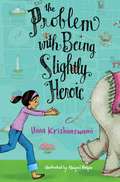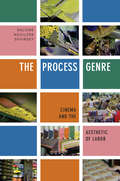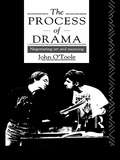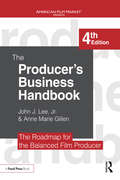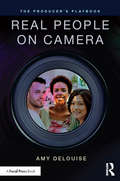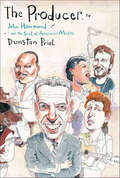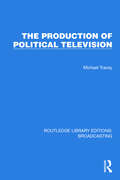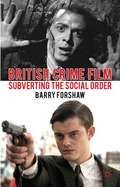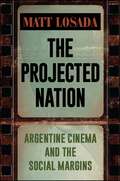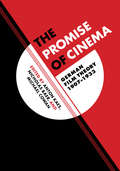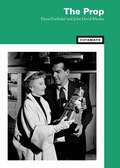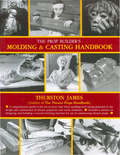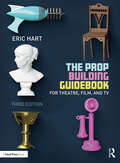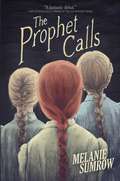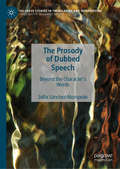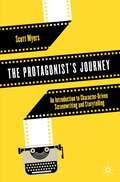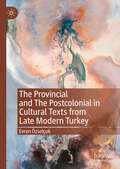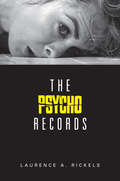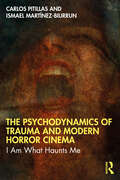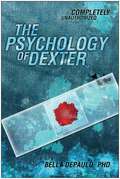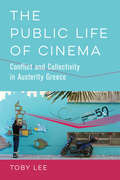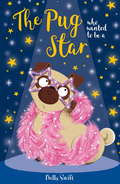- Table View
- List View
The Problem with Being Slightly Heroic
by Uma Krishnaswami Abigail HalpinDini is back from India--with Bollywood star Dolly in tow! But life in the States isn't all rose petal milk shakes...Dini and Maddie, very best friends, are back in the same country at the same time! Better still, Dolly Singh, the starriest star in all of Bollywood, is in America too. Dini's only just returned from India, and already life is shaping up to be as delicious as a rose petal milk shake. Perfect. Then why can't she untie the knot in her stomach? Because so much can go wrong when a big star like Dolly is in town. All Dini has to do is make sure Dolly has everything she needs, from a rose petal milk shake to her lost passport to...a parade? And an elephant? Uh-oh... It's time to think. What Would Dolly Do? If Dini can't figure it out, Dolly might take matters into her own hands--and that will surely lead to the biggest mess of all! Uma Krishnaswami has concocted a delicious sequel to her multiple star-reviewed The Grand Plan to Fix Everything, which Kirkus Reviews called "a delightful romp."
The Process Genre: Cinema and the Aesthetic of Labor
by Salomé Aguilera SkvirskyFrom IKEA assembly guides and “hands and pans” cooking videos on social media to Mister Rogers's classic factory tours, representations of the step-by-step fabrication of objects and food are ubiquitous in popular media. In The Process Genre Salomé Aguilera Skvirsky introduces and theorizes the process genre—a heretofore unacknowledged and untheorized transmedial genre characterized by its representation of chronologically ordered steps in which some form of labor results in a finished product. Originating in the fifteenth century with machine drawings, and now including everything from cookbooks to instructional videos and art cinema, the process genre achieves its most powerful affective and ideological results in film. By visualizing technique and absorbing viewers into the actions of social actors and machines, industrial, educational, ethnographic, and other process films stake out diverse ideological positions on the meaning of labor and on a society's level of technological development. In systematically theorizing a genre familiar to anyone with access to a screen, Skvirsky opens up new possibilities for film theory.
The Process of Drama: Negotiating Art and Meaning
by John O'TooleThe Process of Drama provides an original and invaluable model of the elements of drama in context, and defines how these are negotiated to produce dramatic art. John O'Toole takes the reader through a lively, fascinating account of the relationships between the playwright, the elements of dramatic art, and the other artists involved in this most interactive of creative processes. In doing so he demonstrates - with clarity and wit - how dramatic meaning emerges; how the dramatic event is constructed. Areas covered include: roles and relationships the drama space language and movement tension and the audience gesture and movement This is an essential book for every student of drama who wants to understand how the theatrical art form operates
The Producer's Business Handbook: The Roadmap for the Balanced Film Producer (American Film Market Presents)
by Anne Marie Gillen John J. Lee, Jr.Gain a comprehensive understanding of the business of entertainment and learn to successfully engage in all aspects of global production with the revised and updated 4th edition of The Producer's Business Handbook. Learn how to cultivate relationships with key industry players including domestic and foreign studios, agencies, attorneys, talent, completion guarantors, banks, and private investors. This edition has been updated to include the latest opportunities presented by changing technology and their impact on the producer’s ability to brand, monetize, finance and globally release content. Also included is new information on audience, earning, distribution and funding opportunities created by the explosive growth of VR, AR, 360 and gaming, as well as the rapid conversion to OTT. Additional features include: Completely updated production financing worksheets – an essential tool for producers; Expanded information for low-budget independent producers, internationally-based producers, producers using government funding, and film school students alike; Coverage of China’s changing entertainment landscape, including their entertainment consumption, their commitment to produce content for the big global territories, and more; New, full-color illustrations and graphics that provide a visual representation of complex topics.
The Producer's Playbook: Directing and Working with Non-Actors (The Producer's Playbook)
by Amy DeLouiseProducer’s Playbook: Real People on Camera is a no-nonsense guide for producers looking to get the best performances from "real people" to tell powerful stories on video. Director/producer Amy DeLouise brings years of experience to this resource for creating the best on-screen impact with non-actors for interviews, re-enactments, documentary and direct-to-camera messages. With useful case studies and tips on everything from managing locations and budgeting to strategies for managing crews and the expectations of executive producers and clients, this is an invaluable resource for professionals working in reality TV, documentary, corporate video, and more. Ample case studies with perspectives from industry professionals interviewed by the author, as well as her own plentiful stories from the field Tips are featured in sidebars throughout the text, so that readers can see how the information applies to real situations Full-color photographs allow readers to visualize real world production situations The appendix includes useful templates and checklists for working producers
The Producer: John Hammond and the Soul of American Music
by Dunstan PrialA "behind the music" story without parallelJohn Hammond is one of the most charismatic figures in American music, a man who put on record much of the music we cherish today. Dunstan Prial's biography presents Hammond's life as a gripping story of music, money, fame, and racial conflict, played out in the nightclubs and recording studios where the music was made. A pioneering producer and talent spotter, Hammond discovered and championed some of the most gifted musicians of early jazz—Billie Holliday, Count Basie, Charlie Christian, Benny Goodman--and staged the legendary "From Spirituals to Swing" concert at Carnegie Hall in 1939, which established jazz as America's indigenous music. Then as jazz gave way to pop and rock Hammond repeated the trick, discovering Bob Dylan, Aretha Franklin, Bruce Springsteen, and Stevie Ray Vaughan in his life's extraordinary second act. Dunstan Prial shows Hammond's life to be an effort to push past his privileged upbringing and encounter American society in all its rough-edged vitality. A Vanderbilt on his mother's side, Hammond grew up in a mansion on the Upper East Side of Manhattan. As a boy, he would sneak out at night and go uptown to Harlem to hear jazz in speakeasies. As a young man, he crusaded for racial equality in the music world and beyond. And as a Columbia Records executive—a dapper figure behind the glass of the recording studio or in a crowded nightclub—he saw music as the force that brought whites and blacks together and expressed their shared sense of life's joys and sorrows. This first biography of John Hammond is also a vivid and up-close account of great careers in the making: Bob Dylan recording his first album with Hammond for $402, Bruce Springsteen showing up at Hammond's office carrying a beat-up acoustic guitar without a case. In Hammond's life, the story of American music is at once personal and epic: the story of a man at the center of things, his ears wide open.
The Production of Political Television (Routledge Library Editions: Broadcasting #29)
by Michael TraceyThe Production of Political Television (1977) is a study of the organization and methods of production of political television that covers not only news broadcasts and current affairs programmes but all programmes involved with the policy making process in Britain. It examines the procedures by which producers put their programmes together, and analyses the impact of external institutions on the programme-making process.
The Professionalization of Intelligence Cooperation: Subverting The Social Order (Crime Files)
by Adam D.M. SvendsenPresenting a social history of British crime film, this book focuses on the strategies used in order to address more radical notions surrounding class, politics, sex, delinquency, violence and censorship. Spanning post-war crime cinema to present-day "Mockney" productions, it contextualizes the films and identifies important and neglected works.
The Projected Nation: Argentine Cinema and the Social Margins (SUNY series in Latin American Cinema)
by Matt LosadaThe Projected Nation examines the representation of rural spaces and urban margins in Argentine cinema from the 1910s to the present. The literary and visual culture of the nineteenth and early-twentieth centuries formulated a spatial imaginary—often articulated as an opposition between civilization and barbarism, or its inversion—into which the cinema intervened. As the twentieth century progressed, the new medium integrated these ideas with its own images in various ways. At times cinema limited itself to reproducing inherited representations that reassure the viewer that all is well in the nation, while at others it powerfully reformulated them by filming spaces and peoples previously excluded from the national culture and left behind in the nation's modernizing process. Matt Losada accounts for historical events, technological factors, and the politics of film form and viewing in assessing a selection of works ranging from mass-marketed cinema to the political avant-garde, and from the canonical to the nearly unknown.
The Promise of Cinema
by Anton Kaes Nicholas Baer Michael CowanRich in implications for our present era of media change, The Promise of Cinema offers a compelling new vision of film theory. The volume conceives of "theory" not as a fixed body of canonical texts, but as a dynamic set of reflections on the very idea of cinema and the possibilities once associated with it. Unearthing more than 275 early-twentieth-century German texts, this ground-breaking documentation leads readers into a world that was striving to assimilate modernity's most powerful new medium. We encounter lesser-known essays by Béla Balázs, Walter Benjamin, and Siegfried Kracauer alongside interventions from the realms of aesthetics, education, industry, politics, science, and technology. The book also features programmatic writings from the Weimar avant-garde and from directors such as Fritz Lang and F.W. Murnau. Nearly all documents appear in English for the first time; each is meticulously introduced and annotated. The most comprehensive collection of German writings on film published to date, The Promise of Cinema is an essential resource for students and scholars of film and media, critical theory, and European culture and history.
The Prop (Cutaways)
by John David Rhodes Elena GorfinkelWhat are film props? What do they do? This book answers these questions by a close attention to those material objects that are used to construct cinematic worlds. The term “prop” is short for property. This truncated term’s etymology belies the expansiveness of the concept and indicates the micro and macro scales at which the prop operates. Props are the material—often literal—furniture of cinema’s diegetic reality. Props are also narrative agents: think of the animacy of objects in Jean Epstein’s account of photogénie, the crystal egg in Risky Business, or the domestic bric-à-brac of Sirk’s melodramas. The prop is central to production design and the construction of mise-en-scène. And yet, the prop has rarely—almost never—been taken as an object of analysis and theorization in its own right. This book begins by tracing the prop’s curious but unacknowledged role in film theory, before proceeding to a series of theoretical speculations and close readings that bring the prop into focus. Analyses of scenes of “prop mastery” demonstrate the labor that props perform and enable, as well as the interpretive work they make possible. Across a variety of genres, modes, and historical contexts—studio filmmaking, art cinema, adult and avant-garde films—The Prop introduces readers to the notion of “prop value,” a quality that puts the prop in proximity to the capitalist commodity, but also provides an ironic distance from the commodity’s subjection to exchange value. Gorfinkel and Rhodes argue that the prop is nothing less than a condensation of how labor, subjection, value, and instrumentality underwrite the very conditions of cinema.
The Prop Builder's Molding & Casting Handbook (Technical Theatre, Film And Television Ser.)
by Thurston JamesThe Prop Builder's Molding & Casting Handbook This is the first book to contain, in one comprehensive volume, every molding and casting procedure of use to the theater props builder (no matter what his or her level or proficiency). The author demonstrates the techniques involved in using more than thirty different materials ranging from papier-mache to breakaway glass. While the use of some materials–plaster and polyester resins, for example–is covered to some extent in other publications, information on the selection and use of rubber materials (latex, neoprene, silicone, and the urethanes) and the procedure for making breakaway windows and bottles is available only in The Prop Builder's Molding & Casting Handbook. Written in an easy, conversational style, the book will be useful to anyone involved with theater properties, puppetry, and costuming (as professionals or amateurs). It will also serve admirably the needs of students taking classes in those subjects. Completing the book is a special section on designing and building a vacuum forming machine suitable for use in constructing theater props. More than 450 photographs illustrate the step-by-step procedures explained throughout the entire text.
The Prop Building Guidebook: For Theatre, Film, and TV
by Eric HartNow in its third edition, The Prop Building Guidebook: For Theatre, Film, and TV walks readers through techniques used in historical and contemporary prop making and demonstrates how to apply them to a variety of materials. Experienced prop maker Eric Hart covers the tools and techniques used by professional prop makers throughout the entertainment industry. He outlines a construction process that gives readers the foundational knowledge to choose the best materials and methods for each prop and the background information to know the advantages of these choices. This new edition includes updated information and techniques throughout, including: Over a hundred new images and diagrams Updated terminology, products, and brands used internationally Expanded sections on 3D printing, vacuum forming, foam patterning, and more A new chapter on prop design New information on international safety standards, cleaning, and sanitation More recipes and step-by-step instruction for various finishes Illustrated by hundreds of full-color photographs, this is the most comprehensive guide to prop construction available for professional and student prop makers in theatre, film, and tv. For additional how-to videos, instructional documents, and supplemental information, visit www.propbuildingguidebook.com.
The Prophet Calls
by Melanie SumrowGentry Forrester feels lucky to live among God’s chosen people in the Prophet's compound, but when music is outlawed, Gentry and her older brother, Tanner, sneak out of the community. When they return, all bets are off as the Prophet exercises his control.Born into a polygamous community in the foothills of New Mexico, Gentry Forrester feels lucky to live among God’s chosen. Here, she lives apart from the outside world and its “evils.” On her thirteenth birthday, Gentry receives a new violin from her father and, more than anything, she wants to play at the Santa Fe Music Festival with her brother, Tanner. But then the Prophet calls from prison and announces he has outlawed music in their community and now forbids women to leave. Determined to play, Gentry and Tanner sneak out. But once they return, the Prophet exercises control from prison, and it has devastating consequences for Gentry and her family. Soon, everything Gentry has known is turned upside down. She begins to question the Prophet’s teachings and his revelations, especially when his latest orders put Gentry’s family in danger. Can Gentry find a way to protect herself and her family from the Prophet and escape the only life she’s ever known? This realistic, powerful story of family, bravery, and following your dreams is a can't-miss debut novel from Melanie Sumrow.
The Prosody of Dubbed Speech: Beyond the Character's Words (Palgrave Studies in Translating and Interpreting)
by Sofía Sánchez-MompeánThis book offers a descriptive and practical analysis of prosody in dubbed speech, examining the most distinctive traits that typify dubbed dialogue at the prosodic level. The author's unique perspective - as both a translation studies researcher and a voice-over professional - helps to bring these two aspects of the dubbing process together into a coherent study for the first time. Supported by corpus analysis of English and Spanish episodes of US TV show How I Met Your Mother, she examines aspects of prosody in source and target languages, including features such as intonation, loudness, tempo, rhythm and tension. This book will be of interest to students and scholars of translation and interpreting, media studies, television and film production, as well as dubbing professionals.
The Protagonist's Journey: An Introduction to Character-Driven Screenwriting and Storytelling
by Scott MyersCharacter drives plot. Based on this principle, this book walks aspiring writers through the fascinating world of character-driven screenwriting. When a writer engages their characters, they start a process which naturally leads to the story’s structure and everything else that makes for a well-written narrative. Exploring the protagonist’s journey and their “unity arc,” Myers explains how a family of characters surrounds the protagonist and influences their transformation process. This easy-to-follow guide features activities that will help writers of any level develop their stories from concept to scene-by-scene outline. Based upon a popular workshop Myers has led with over a thousand writers at all levels of experience, this book is a must-have for screenwriting students, both undergraduate and graduate, and those looking at advanced story development.
The Provincial and The Postcolonial in Cultural Texts from Late Modern Turkey
by Evren ÖzselçukThis book explores Turkey’s complicated relationship to modernity and its status within the new global order by tracing the ambivalent ways in which taşra (the provinces) is constituted in contemporary Turkish cinema and literature. Connoting much more than its immediate spatial meaning as those places outside of the center(s), taşra is a way of naming what modernity decries as spatial peripherality, temporal belatedness, and cultural backwardness. It has functioned historically as a psychosocial repository for what Turkish modernity degrades and disavows, enabling a mapping of the predicaments and contradictions of Turkish modernization and national identity-constitution. Organized around taşra as its central analytic and informed by postcolonial, psychoanalytical, and critical theory, the book examines the extent to which dominant codings of taşra are affirmed and/or complicated in cinematic and literary narratives by award-winning filmmakers Nuri Bilge Ceylan and Fatih Akın and Nobel laureate Orhan Pamuk.
The Psycho Records
by Laurence Rickels?The Psycho Records follows the influence of the primal shower scene within subsequent slasher and splatter films. American soldiers returning from World War II were called "psychos" if they exhibited mental illness. Robert Bloch and Alfred Hitchcock turned the term into a catch-all phrase for a range of psychotic and psychopathic symptoms or dispositions. They transferred a war disorder to the American heartland. Drawing on his experience with German film, Hitchcock packed inside his shower stall the essence of schauer, the German cognate meaning "horror." Later serial horror film production has post-traumatically flashed back to Hitchcock's shower scene. In the end, though, this book argues the effect is therapeutically finite. This extensive case study summons the genealogical readings of philosopher and psychoanalyst Laurence Rickels. The book opens not with another reading of Hitchcock's 1960 film but with an evaluation of various updates to vampirism over the years. It concludes with a close look at the rise of demonic and infernal tendencies in horror movies since the 1990s and the problem of the psycho as our most uncanny double in close quarters.
The Psychoanalysis of Artificial Intelligence (The Palgrave Lacan Series)
by Isabel MillarThis book examines the crucial role of psychoanalysis in understanding what AI means for us as speaking, sexed subjects. Drawing on Lacanian theory and recent clinical developments it explores what philosophy and critical theory of AI has hitherto neglected: enjoyment. Through the reconceptualization of Intelligence, the Artificial Object and the Sexual Abyss the book outlines the Sexbot as a figure who exists on the boundary of psychoanalysis and AI. Through this figure and the medium of film, the author subverts Kant’s three Enlightenment questions and guides readers to transition from asking 'Does it think?' to 'Can it enjoy?' The book will appeal in particular to students and scholars of psychoanalysis, philosophy, film and media studies, critical theory, feminist theory and AI research.
The Psychodynamics of Trauma and Modern Horror Cinema: I Am What Haunts Me
by Carlos Pitillas Ismael Martínez-BiurrunIn this illuminating volume, Carlos Pitillas and Ismael Martínez-Biurrun provide in-depth analysis of contemporary horror films from a psychoanalytic perspective.Drawing on Freudian psychoanalysis, object relations theory and relational psychoanalysis, the authors explore the ways in which horror films present different aspects of traumatic phenomenology and the re-emergence of unprocessed traumatic wounds. Covering films as diverse as Psycho, The Babadook, Black Swan, and A Nightmare on Elm Street, the authors dissect the use of symbolism and metaphors in popular horror cinema to show how the disruptive threats faced by characters in these films often function in the same way as post-traumatic stress disorder, and consider behaviours such as repetitive thoughts and actions, dissociation, and more through the lens of neuroscience and narrative theory.This book is an important and novel read for all psychoanalysts in practice and training looking for new ways to understand and work with clients who have experienced traumatic life events. The authors’ use of familiar and canonical horror films also equips students and researchers of film studies with the knowledge necessary to integrate psychoanalytic theories into their work.
The Psychology of Dexter
by Bella DepauloPeek inside the mind of Dexter Morgan—police forensic analyst, family man, serial killer, and the star of Showtime&’s most-watched series—with essays from seventeen psychologists and avid fans. Aimed at Dexter devotees and armchair psychologists, The Psychology of Dexter takes on the psychological complexities of the popular series with an eye towards insight and accessibility. It analyzes not just the title character, but his family, coworkers, and even his viewers. What makes Dexter tick? What makes a show about a serial killer so appealing to those of us at home. And do we need to be worried about our own Dark Passengers? From the implications of faking normalcy (could it be behind Dexter&’s still-in-progress emotional growth?) to where the show weighs in on the psychological debate between nature and nurture, this book gives fans a peek inside Dexter&’s psyche. Think you know Dexter? The Psychology of Dexter will make you think again.
The Pub Landlord's Great British Pub Quiz Book
by Al MurrayWho invented the pub quiz? The British, of course! Who doesn?t enjoy a rousing question-and-answer session over a pint and some scratchings? Indeed, what higher calling is there than standing in the pub loudly demanding answers to difficult questions like `d'you want some?? Here, for your pleasure, Britain?s leading pub landlord, The Pub Landlord, presents the finest collection of facts imaginable. Enjoy the attention of friends and strangers by revealing how many James Bonds there were, how many times the French have capitulated and exactly how long those pickled eggs have been in that jar on the bar. The ladies love a well-read man and this book will give you the tools needed to impress her (don?t worry, answers are included). None of your French-type philosophical musings here. No, this is a proper quiz for the Great British Public. In a public house. Or your living room.
The Pub Landlord's Great British Pub Quiz Book
by Al MurrayWho invented the pub quiz?The British, of course!Who doesn't enjoy a rousing question-and-answer session over a pint and some scratchings? Indeed, what higher calling is there than standing in the pub loudly demanding answers to difficult questions like 'd'you want some?' Here, for your pleasure, Britain's leading pub landlord, The Pub Landlord, presents the finest collection of facts imaginable. Enjoy the attention of friends and strangers by revealing how many James Bonds there were, how many times the French have capitulated and exactly how long those pickled eggs have been in that jar on the bar.The ladies love a well-read man and this book will give you the tools needed to impress her (don't worry, answers are included). None of your French-type philosophical musings here. No, this is a proper quiz for the Great British Public. In a public house. Or your living room.(P)2010 Hodder & Stoughton
The Public Life of Cinema: Conflict and Collectivity in Austerity Greece
by Toby LeeIs culture a luxury? In this era of austerity, the value of the arts has been a topic of heated debate in Greece, where the country’s economic troubles have led to drastic cuts in public funding and much contention over the significance of cultural institutions and government-funded arts initiatives. At issue in these debates are larger questions regarding the very notions of publicness, hierarchies of value, and functions of the state that structure collective life. Beginning with the Thessaloniki International Film Festival, How to Be Public tracks this turbulence as it unfolded in the Greek film world in the early years of the crisis. Investigating the different forms of citizenship and collectivity being negotiated in cinema’s social spaces, this book considers how the arts and cultural production may illuminate the changing conditions of, and possibilities for, public and collective life in the neoliberal era.
The Pug Who Wanted to be a Star (The Pug Who Wanted to be... #7)
by Bella SwiftPeggy the pug is only little, but she's going to be a BIG star! A show-stopping new story about the loveable heroine of THE PUG WHO WANTED TO BE A UNICORN.When Peggy the pug's friend Chloe is cast as Wendy in the school production of PETER PAN, Peggy feels left out. Chloe is too busy learning lines and going to rehearsals to play with her. So Peggy sets out to show Chloe that she has star quality, too. When a hilarious video of Peggy goes viral, Peggy becomes a celebrity overnight. Suddenly, she can't even go for a a walk to the park without being stopped for a selfie. Maybe fame isn't all it's cracked up to be . . . But when Chloe gets stage fright, Peggy knows the show must go on! A heartwarming and gently humorous story about realising that your family are always your biggest fans.
